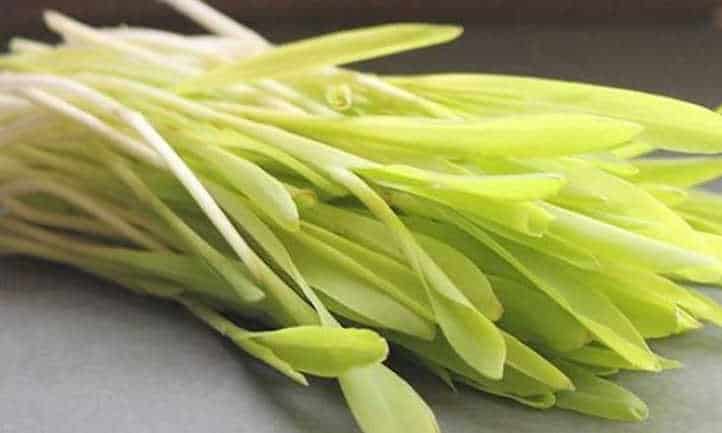Microgreens are healthy for your body, they do wonders for your brain, liver, kidneys, heart, and of course, your skin. But, have you ever wondered what do microgreens taste like? After all, we’re made to believe that green vegetables, especially microgreens are often tasteless and bland.
Well, need not worry. In this article, I’ll tell you what do microgreens taste like and how to make them tastier and more suited to your tastebuds.
What Do Microgreens Taste Like
Microgreens are young leafy greens that are harvested when they are approximately 1-3 inches tall. They are typically grown from the seeds of vegetables, herbs, or other plants, and they are often used as a garnish or visual element in dishes.
However, microgreens also have a distinct flavor that can add a new dimension to your cooking. For example, microgreens such as radish, arugula, and mustard greens tend to be peppery and sharp, while microgreens like spinach and chard have a more mellow flavor. Herbs like cilantro and basil also make excellent microgreens, and they can add a fresh, grassy taste to your dish.
Experimenting with different types of microgreens is a great way to enhance the flavor of your food. But, if you’re not sure what do microgreens taste like, here are a few tips to help you get started.
Start With A Small Amount
When you’re first trying out microgreens, it’s best to start with a small amount. This will allow you to get a feel for the flavor without overwhelming your dish.
Add Them At The End Of Cooking
Microgreens are delicate and can lose their flavor if they’re cooked for too long. For this reason, it’s best to add them at the end of cooking or as a garnish.
Pair Them With Complimentary Flavors
Microgreens can be paired with other ingredients that have complementary flavors. For example, if you’re using peppery microgreens, pair them with sweet or savory dishes.
Use Them In Place Of Other Green Vegetables
Microgreens can also be used in place of other greens in recipes. For example, if a recipe calls for spinach, try using arugula microgreens instead.
Don’t Shy Away From Getting Creative With Your Food
There are endless ways to use microgreens in your cooking. So, don’t be afraid to get creative and experiment with different flavors and combinations.
These are just a few tips to help you get started with understanding what do microgreens taste like. As you experiment with different types of microgreens, you’ll develop a better understanding of how to use them to enhance the flavor of your dishes.
So, go ahead and give them a try!
Which Microgreens Are The Tastiest
Microgreens are young greens that are usually no more than 14 days old. They are packed with nutrients and have a milder flavor than mature greens. The most common microgreens include arugula, beet greens, cabbage, chard, cilantro, kale, and radish greens.
Although they are all quite tasty, some microgreens stand out for their exceptional flavor. Arugula microgreens have a spicy kick that is perfect for adding flavor to salads and sandwiches. Beet greens have a sweetness that is reminiscent of beets, making them a great addition to smoothies and juices. Cabbage microgreens have a slightly bitter taste that many people enjoy in slaws and stir-fries. Chard microgreens are milder in flavor than chard leaves, making them a good choice for those who want to enjoy the health benefits of chard without the strong taste.

Cilantro microgreens have a pungent flavor that is perfect for garnishing tacos and other Mexican dishes. Kale microgreens have a slightly earthy flavor that goes well in soups and stews. Radish microgreens have a sharp flavor that is often used as a garnish or to add flavor to salads.
These are just a few of the tastiest microgreens that you can grow at home.
If you’re looking for a way to add flavor to your dishes, give them a try!
Why Should You Eat Microgreens
Microgreens are immature versions of salad greens. They have become popular recently as a source of vitamins and minerals, as well as antioxidants. Microgreens contain up to 40 times more nutrients than their full-grown counterparts.
They are also a source of fiber and phytochemicals, which are beneficial plant compounds that have been linked to a reduced risk of chronic diseases such as cancer and heart disease. Microgreens are relatively easy to grow at home and can be used in salads, sandwiches, and other dishes.
If you are looking for nutrient-rich food that can add flavor and color to your meals, consider microgreens.
What Do Microgreens Taste Like?
Microgreens can have a variety of different flavors, depending on the type of microgreen. They can be spicy, sweet, savory, or even bitter. The flavor of microgreens is often more intense than their full-grown counterparts.

For example, arugula microgreens have a spicy kick that is perfect for adding flavor to salads and sandwiches. Beet greens have a sweetness that is reminiscent of beets, making them a great addition to smoothies and juices. Cabbage microgreens have a slightly bitter taste that many people enjoy in slaws and stir-fries. Chard microgreens are milder in flavor than chard leaves, making them a good choice for those who want to enjoy the health benefits of chard without the strong taste.
Cilantro microgreens have a pungent flavor that is perfect for garnishing tacos and other Mexican dishes. Kale microgreens have a slightly earthy flavor that goes well in soups and stews. Radish microgreens have a sharp flavor that is often used as a garnish or to add flavor to salads.
These are just a few of the tastiest microgreens that you can grow at home.
Conclusion
Microgreens are a type of edible greens that are typically grown from the seeds of vegetables, herbs, or other plants. They are usually harvested when they are between one and three inches tall and can be used in a variety of dishes. While microgreens may be small in size, they pack a powerful punch when it comes to flavor.
Depending on the type of microgreen, they can have a slightly sweet taste or a more peppery flavor. Microgreens can be used as a garnish or added to salads, sandwiches, soups, and other dishes for a burst of flavor.
Whether you’re looking to add a bit of zing to your meal or want to experiment with new flavors, microgreens are a great option.

